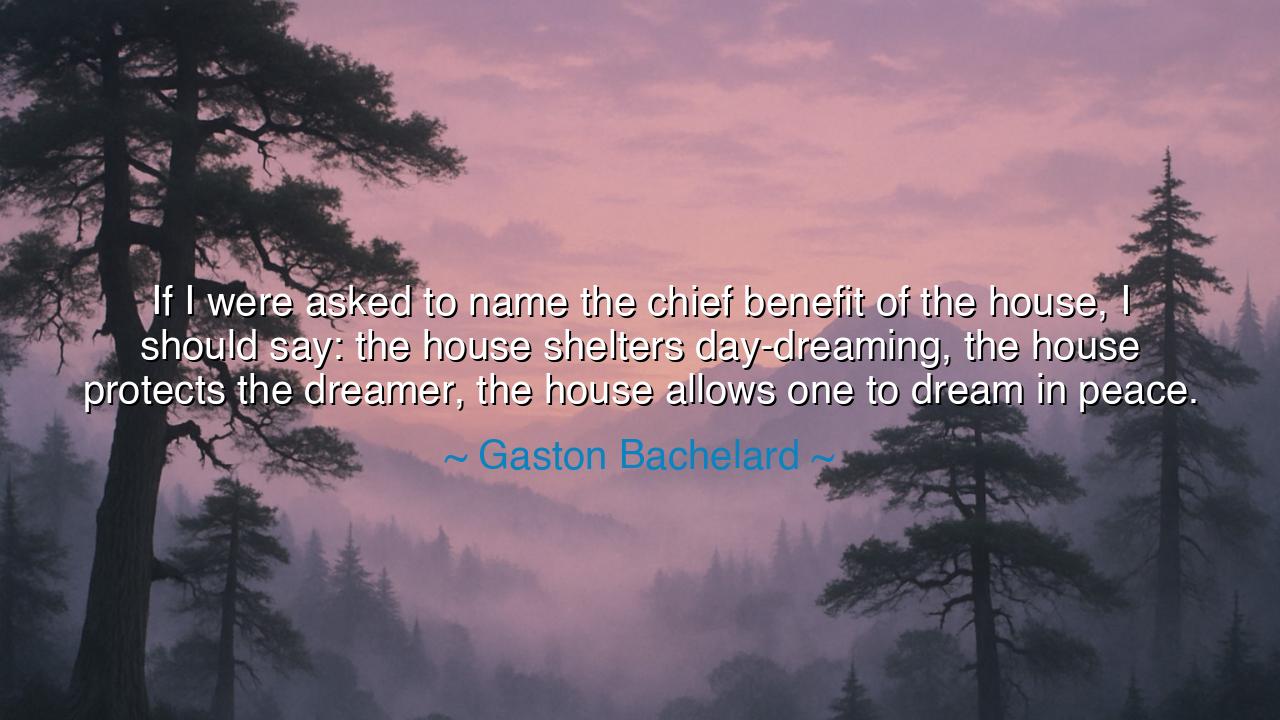
If I were asked to name the chief benefit of the house, I should
If I were asked to name the chief benefit of the house, I should say: the house shelters day-dreaming, the house protects the dreamer, the house allows one to dream in peace.






“If I were asked to name the chief benefit of the house, I should say: the house shelters day-dreaming, the house protects the dreamer, the house allows one to dream in peace.” Thus spoke Gaston Bachelard, the French philosopher and poet of the imagination, whose words were not about wood or walls, but about the sacred architecture of the soul. In this gentle reflection, he unveils the house not as a structure of stone, but as a sanctuary of the spirit, a vessel in which the fragile dreams of humankind may take root and grow. For Bachelard knew that while the body seeks warmth and safety, it is the dreamer within who seeks a place to imagine, to remember, and to hope.
In the ancient understanding, the home was more than shelter — it was a symbol of being. The house stood as the axis between earth and heaven, between the known and the infinite. Within its walls, a person found not only rest, but identity. It is here that the day-dreamer — that tender, inward voyager — could wander freely, exploring the hidden continents of the mind. To dream in peace is no small thing; it is to be allowed the freedom to imagine without fear, to create without interruption. And this, Bachelard teaches, is the chief benefit of the house — that it gives the imagination a dwelling place, as vital to the soul as food is to the body.
In a world that rushes and clamors, the house becomes the last fortress of silence and wonder. It protects the dreamer from the noise of the crowd, the demands of the day, and the cold indifference of the world. Within its quiet spaces — the soft corner by the window, the room where morning light spills like gold — the spirit begins to expand. The mind, free from fear, turns inward and upward, weaving visions, recalling childhood, creating new worlds. To Bachelard, this quiet dreaming is not idleness, but the very essence of human life — the moment when the inner world flowers and meaning is born.
Think of the story of Emily Dickinson, who lived much of her life in seclusion, within the small, white house on Main Street in Amherst. To others, her retreat might have seemed confinement. But within those walls, she found her universe — a world of bees and eternity, of death and dawn, of love unseen but deeply felt. Her home sheltered her day-dreaming, protected her imaginative fire, and allowed her to dream in peace. Out of that stillness came poems that shimmered with eternity — proof that sometimes, the house not only shelters the dreamer, but gives birth to dreams that outlive the dreamer herself.
To Bachelard, then, the house is a mirror of the soul. Its corners hold our memories; its stairways echo our thoughts; its attic, our imagination; and its cellar, our fears. To dwell well is to dwell consciously — to let one’s home become a companion in the great inward journey of life. It is in this sacred dwelling that the self gathers strength, finds refuge from chaos, and learns the art of reflection. The house, in this way, is not just a physical structure — it is the temple of the inner life, the womb of creativity and serenity.
And yet, not all houses are built of stone and timber. Some are made of love, of friendship, of trust — invisible yet enduring. Wherever one is sheltered enough to dream without fear, there stands a house in the truest sense. The wanderer who carries peace within his heart builds his home wherever he rests his head. The artist who finds inspiration beneath an open sky, the thinker who shapes visions in solitude — they, too, dwell in the house Bachelard describes. For the essence of the house is not in its walls, but in the protection it gives to the dreamer.
Lesson: Guard the spaces that allow your soul to breathe. Build your life around the quiet sanctuaries — physical or spiritual — that protect your dreaming self. Do not neglect the need for peace, for from peace springs creation. Keep a corner of your world sacred: a place for stillness, reflection, and wonder. For it is in these small, protected spaces that imagination awakens, and in imagination that humanity becomes whole.
So remember, as Gaston Bachelard taught, the true purpose of the house is not merely to shelter the body, but to shelter the soul. It is there that you will find yourself again — not as worker, or citizen, or role, but as dreamer — alive, free, and quietly infinite.






AAdministratorAdministrator
Welcome, honored guests. Please leave a comment, we will respond soon